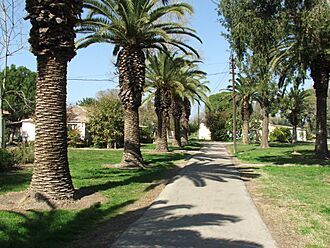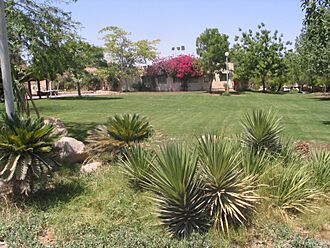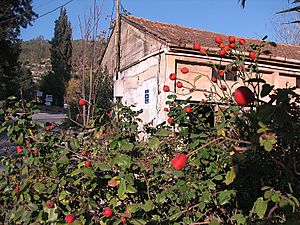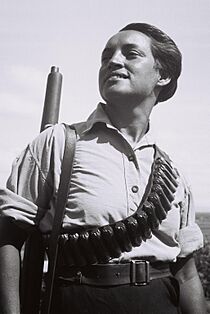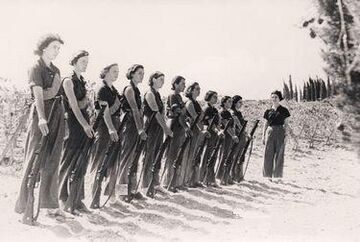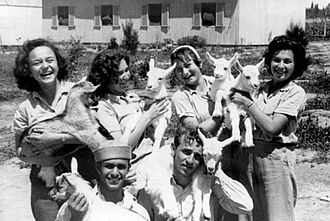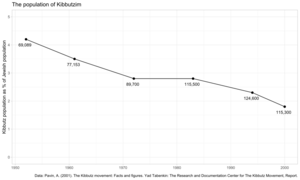Kibbutz facts for kids
A kibbutz (pronounced: kib-BOOTS) is a special type of community in Israel. It started as a place where people lived and worked together, usually on farms. The very first kibbutz, called Degania Alef, was created in 1910.
Over time, kibbutzim have changed. While farming is still important, many now have factories and even high-tech businesses. Kibbutzim began with big ideas about sharing everything and working for the good of everyone. They combined ideas from socialism (where everyone is equal) and Zionism (the idea of a Jewish homeland).
In recent years, some kibbutzim have become more like regular towns, with people earning different amounts of money. A person who lives in a kibbutz is called a kibbutznik.
In 2010, there were 270 kibbutzim in Israel. About 126,000 people lived in them. Their factories and farms make a lot of money for Israel. For example, they produce 9% of Israel's industrial goods and 40% of its farm products. Some kibbutzim even make high-tech and military items.
Today, kibbutzim belong to different groups. The main one is the secular Kibbutz Movement. There is also the Religious Kibbutz Movement and a smaller religious group called Poalei Agudat Yisrael.
Contents
How Kibbutzim Started
The First Communities
Kibbutzim were founded by Jewish people who moved to Palestine. Many of them, like those from the Second Aliyah (a wave of immigration from 1904-1914), wanted to be farmers. This was one of the few jobs available in Palestine at the time.
The first kibbutz, Degania Alef, was founded in 1910. Some of the founders were inspired by ancient Greek ideas, especially about education and living together.
One of the early kibbutz pioneers, Yosef Baratz, wrote about their dreams:
We were happy enough working on the land, but we knew more and more certainly that the ways of the old settlements were not for us. This was not the way we hoped to settle the country—this old way with Jews on top and Arabs working for them; anyway, we thought that there shouldn't be employers and employed at all. There must be a better way.
Life in Palestine was very tough back then. Much of the land was swampy, rocky, or desert. Most settlers had never farmed before. Diseases like malaria were common. Also, there were attacks on farms and crops. Living together in a group made people safer. It also made it easier to start a farm, which cost a lot of money.
Jewish people around the world helped buy land in Palestine. In 1909, Baratz and eleven other young people started their community near the Sea of Galilee. They called it "Kvutzat Degania."
The work was extremely hard. Many people left because of the difficulties. But by 1914, Degania had fifty members. More kibbutzim were then started in the area.
During British Rule
After World War I, the British took control of Palestine. This made it easier for Jewish people to move there and buy land. Many Jews fled Eastern Europe because of rising antisemitism (hatred of Jews). Tens of thousands came to Palestine in the 1920s. This was called the Third Aliyah.
Youth groups in Europe helped young Jews prepare for life on kibbutzim. They learned about farming before they even arrived.
In the early days, kibbutz meetings were mostly about work. But in the 1920s and 1930s, they became more social. People would sit around a campfire, dance, and sing. One woman remembered: "Oh, how beautiful it was when we all took part in the discussions... sparks would unite in one great flame."
Kibbutzim founded in the 1920s were often larger than the first ones. Degania started with 12 members, but Ein Harod, founded just ten years later, began with 215 members.
Kibbutzim grew a lot in the 1930s and 1940s. In 1922, about 700 people lived on kibbutzim. By 1950, this number jumped to 65,000. The population of kibbutzim reached its highest point in 1989, with 129,000 people.
Kibbutz Groups Form
Different kibbutz groups started to form. In 1927, the United Kibbutz Movement was created. Some kibbutzim, like those from Hashomer Hatzair, formed their own group called Kibbutz Artzi.
These groups had different ideas. Some, called Kvutzot, wanted to stay small (under 200 members) to keep trust among everyone. Others, like those in the United Kibbutz Movement, tried to accept as many members as possible. Givat Brenner grew to have over 1,500 members!
Kibbutz Artzi kibbutzim were very focused on gender equality. Women would call their husbands "my man" instead of "my master." Children often slept in special children's houses and only saw their parents for a few hours a day.
There were also differences in religion. Many kibbutzim were secular, meaning they didn't follow traditional religious practices. They still celebrated Jewish holidays, especially those connected to farming, like Passover and Sukkot. But they didn't pray daily.
Religious kibbutzim were also formed, creating the Religious Kibbutz Movement. The first religious kibbutz was Ein Tzurim, founded in 1946.
Helping Build the State
As more Jewish settlers came to Palestine, tensions grew with the Arab population. There were riots and violence in the 1920s and 1930s.
Kibbutzim started to play a big role in defense. They bought or made rifles, and members practiced shooting. Yigal Allon, an Israeli leader, explained that kibbutzim were chosen for their locations not just for farming, but also for defense. They were like guard posts for the Jewish community.
Kibbutzim also helped define the future borders of Israel. When it seemed Palestine might be divided, new kibbutzim were quickly built in faraway areas. This helped ensure that these lands would become part of the Jewish state. For example, in 1946, eleven new kibbutzim were built in the Negev desert in just one day!
Kibbutzniks fought bravely in the 1948 Arab–Israeli War, which led to the creation of Israel. They gained a lot of respect. Members of Kibbutz Degania helped stop Syrian tanks with Molotov cocktails. Another kibbutz, Maagan Michael, secretly made bullets for the war.
After Israel Was Founded
After Israel was established, many Jewish refugees came from Europe and Arab countries. This brought new opportunities and challenges for kibbutzim. They could grow with new members and workers. However, it also meant that kibbutzim, mostly made up of Jews from Eastern Europe, had to learn to live with Jews from different backgrounds, like those from Morocco or Iraq.
There were also big arguments about politics. Israel was recognized by both the United States and the Soviet Union at first. But Israel slowly sided with the West. This caused disagreements within the kibbutz movement. Some kibbutzim even split up because of these arguments.
Another debate was about money from Germany given to Holocaust survivors. Should this money be shared with the whole kibbutz, or should survivors keep it? Eventually, many kibbutzim let survivors keep some or all of their money.
By the 1960s, kibbutzim were doing very well. Their standard of living improved faster than most of Israel. Many kibbutz swimming pools were built during this time.
Kibbutzim continued to play a big role in Israel's defense. Many were founded by army groups called Nahal along Israel's borders. In the Six-Day War, a large number of soldiers who died were from kibbutzim. Kibbutzniks also had a lot of power in the Israeli parliament. Even though they were only 4% of the population, they made up 15% of the parliament.
By the 1970s, kibbutzim seemed to be thriving. People worked in jobs that were usually for working-class people, but they enjoyed a middle-class lifestyle.
Changes and Challenges
Over time, some kibbutz members felt less connected to the kibbutz's original goals. This happened because of personal frustrations and because some members started to have careers outside the kibbutz, earning more money and gaining more status. The balance between individual needs and kibbutz values began to shift.
- More Private Life: Israeli society became more focused on individual ownership, and these ideas started to influence new generations in the kibbutzim.
- Struggles to Adapt: Kibbutzim were designed to be very structured. But when society changed, some kibbutz leaders found it hard to adapt. They sometimes used solutions that went against the original kibbutz ideas.
- Changing Society: Kibbutzim were rural, but Israel became more urban. This made the kibbutz way of life feel less connected to the rest of the country.
- Loss of Pioneer Spirit: The original kibbutzim were built on the idea of self-sacrifice for the community and the country. As this "pioneer spirit" faded, the strong bond between members weakened.
- Outside Influences: When kibbutz members were allowed to have TVs in their homes, they saw how people outside the kibbutz lived. They saw people getting paid for their work and buying luxury items. Kibbutzim struggled to deal with these new ideas.
- Global Changes: The fall of communist countries around the world also weakened socialist ideas, including those in kibbutzim.
Because of these challenges, many people started leaving kibbutzim in the 1980s. To deal with this, some kibbutzim began to change.
These changes included:
- Privatizing Services: Many kibbutzim started charging for services like education and healthcare, which used to be free for members.
- Different Wages: Originally, everyone in a kibbutz received the same amount of money, no matter what job they did. Now, many kibbutzim pay members differently based on their work.
- Private Property: Some kibbutzim started allowing members to own their homes and even a share in the kibbutz businesses. This meant members could sell or pass on these properties.
Since the mid-1990s, more and more kibbutzim have made these changes. Only a few dozen still follow the very traditional model. These new kibbutzim are called "renewing kibbutzim," while the traditional ones are called "collaborative."
Today, there are three main ways kibbutzim pay their members:
- Traditional Collective Kibbutz: Everyone gets paid equally, no matter their job.
- Mixed Model Kibbutz: Members get a small part of their salary based on their work, plus a basic amount given equally to everyone.
- Renewing Kibbutz: A member's income comes only from their individual work, sometimes with extra money from kibbutz businesses.
A 2012 study found that most kibbutzim (72%) had become "renewing kibbutzim," which are more individualistic.
Kibbutz Ideas
The first Jewish immigrants to kibbutzim were mostly secular. This meant they focused on a strong work ethic instead of religious practices. They believed that hard work on the land was very important.
Kibbutz members were not exactly like communists, even though they shared things. They believed in active democracy, where members voted on important decisions.
Kibbutzim were not the only shared communities. There were also moshavim, where people farmed together but had more private lives.
Today, most kibbutzim vote for centrist or left-leaning political parties in Israel.
Daily Life in a Kibbutz
The idea of equality was very important in kibbutzim until the 1970s. Kibbutzniks didn't own their own tools or even clothes. Any money or gifts from outside were given to the common fund. Meals were eaten together in a big dining hall. This was a key part of living as a community.
Children's Lives
When the first children were born, the kibbutz faced a challenge. They wanted men and women to be equal. They thought that if women were tied to childcare, they couldn't work in farming or factories like men. So, they decided that children would be raised communally.
The founders also believed that parents shouldn't "own" their children. They thought it was selfish for parents to control their kids too much.
To solve this, they created communal children's houses. Children spent most of their time there, learning, playing, and sleeping. Parents would spend a few hours each afternoon with their children after work.
This collective child-rearing was also meant to break away from old traditions where fathers had all the power. Children would not depend on their fathers for money or social status.
In the children's houses, trained nurses and teachers took care of the kids. The idea was that parents and children would have better relationships because parents wouldn't always have to be the ones to discipline them. Children grew up together with others born in the same year. The community paid for everything the children needed.
The founders wanted children to learn from life and physical work, not just books. They wanted a free and creative environment.
Adults tried to make the children's houses feel like homes. They furnished them for different age groups, with courtyards and playgrounds.
The kibbutz believed that early childhood was very important for a child's growth. They focused on helping children develop their individuality and creativity. However, this system also meant that children were taught kibbutz values, which sometimes led to less individuality. It was also a big change from the traditional Jewish focus on the nuclear family.
Some children who grew up in these communal houses loved it, while others had mixed feelings. Some felt it was hard to grow up without their parents living with them. One woman described her childhood:
Allowed to suckle every four hours, left to cry and develop our lungs, we grew up without the basic security needed for survival. Sitting on the potty at regular intervals next to other children doing the same, we were educated to be the same; but we were, for all that, different.... At night the grownups leave and turn off all the lights. You know you will wet the bed because it is too frightening to go to the lavatory.
However, children in kibbutzim still had strong bonds with their parents because they spent a few hours with them every day. Studies have shown that children who grew up communally sometimes had more difficulty with strong emotional connections later in life, but they often had many less-intense friendships.
The way children were raised in kibbutzim was largely based on what adults thought was best for the community, especially for gender equality.
Higher Education
At first, higher education wasn't seen as very important because most work was in farming. But as kibbutzim started to have factories and other industries, more young people went to universities. The number of kibbutz students going to college increased a lot. Originally, the kibbutz paid for all college tuition. But during the kibbutz crisis in the 1980s, some started paying less.
Gender Equality
The idea of gender equality in kibbutzim is complex. Some say women were always equal, while others say there was always some inequality.
In the early days, women did many of the same jobs as men, including working in the fields and doing heavy labor. But they also did traditional female jobs like cooking and cleaning.
There was no traditional marriage in the early kibbutzim. If a couple wanted to be together, they just asked for a room. This was meant to free women from depending on a man.
When children arrived, the communal dining and laundry services were already in place to free women. The children's houses were also created so women could work outside the home. This was a key idea for women's liberation.
However, women born on kibbutzim often preferred traditional female roles. Eventually, most women moved into service jobs. The second generation of women also ended the children's houses. They wanted their own children to live at home with them.
Today, most women in kibbutzim work in service and domestic jobs, while men work in production. For example, in 1948, about 78% of women worked in services (like childcare and education), compared to only 16% of men. Only 15% of women worked in production, compared to 58% of men. By 1979, only 9% of women were doing farm work.
Social Life

Social life was also shared. For example, dining halls often had benches instead of chairs to show communal values. At first, married couples were even discouraged from sitting together, as marriage was seen as too exclusive.
In the early days, members weren't allowed to have individual items like teakettles. Everything was shared. But starting in the 1950s and 1960s, people could have some personal items like books or radios. Having a few books was fine, but a private car was not. Cars were owned by the community and had to be requested.
Communal life was hard for some. Many new members left after a few years. Since kibbutzniks didn't have their own bank accounts, buying anything outside the kibbutz store needed approval from a committee, which could be frustrating.
There were also members who didn't work hard, or who misused shared property. These "parasites" were not well-regarded. However, most people in kibbutzim were not lazy. Public opinion was a strong tool against those who didn't do their part.
Kibbutzim were small, isolated communities, so gossip was common. This was made worse by the lack of privacy and strict work schedules.
Big decisions were made by voting or by everyone agreeing. But daily work assignments were made by elected leaders. Kibbutzniks would check a duty sheet in the dining hall to see their jobs.
Kibbutzim tried to rotate people through different jobs. One week someone might work in planting, the next with animals, then in a factory, and then in the laundry. Even managers had to do simple jobs. This meant everyone experienced different types of work, but it made it harder for people to specialize.
Kibbutzim were known for supporting arts and culture. Many kibbutzniks became writers, actors, or artists. They often had theater groups, choirs, and sports leagues.
Kibbutz Economy
Early kibbutzim tried to grow all their own food, but they soon realized this wasn't possible. Land was usually provided by the Jewish National Fund. Later, they relied on government help.
Even before Israel was founded, kibbutzim started to move beyond farming into manufacturing. For example, Degania Alef opened a factory that made tools for cutting diamonds, earning millions of dollars a year. Kibbutz Hatzerim has a factory that makes drip irrigation equipment, which is now a huge international company. Maagan Michael started by making bullets and now makes plastics and medical tools.
A big wave of kibbutz industrialization happened in the 1960s. By 2012, only 15% of kibbutz members worked in agriculture.
Hiring outside workers was always a debated topic. During harvest time, kibbutzim needed extra help. The founders wanted Jews to do all the manual labor, so hiring non-Jews was controversial. In the 1970s, kibbutzim often hired Arab workers. Since the 1990s, many foreign workers from countries like Thailand and China have been hired.
Kibbutzim have also started to get involved in tourism. Many rent out rooms or run guesthouses. Some, like Kibbutz Lotan, offer bird-watching trips and eco-tours, showing off their sustainable technologies like mud huts.
In 2010, there were 270 kibbutzim in Israel with a population of 126,000.
Today, some kibbutzim run very large businesses. Their factories and farms make up a big part of Israel's economy. For example, Kibbutz Sasa, with only about 200 members, made $850 million in one year from its military-plastics factory. Kibbutz Ketura is a leader in solar technology.
Types of Kibbutzim
There are three main kibbutz movements:
- The Kibbutz Movement: This is the largest group, combining two older movements.
- The Religious Kibbutz Movement.
- Poalei Agudat Yisrael: A smaller religious group.
Many kibbutzim were started by youth groups connected to Israeli movements.
In 2005, Israel created new legal definitions for kibbutzim:
- Kibbutz Shitufi: This is a traditional kibbutz that still shares everything.
- Kibbutz MitChadesh: This is a "renewing kibbutz" that has made some changes, like allowing different wages, but still keeps some shared principles.
- Urban kibbutz: These are communities that exist inside a city. They don't have their own businesses, and members work outside the kibbutz. Examples include Tamuz in Beit Shemesh.
A mixed type of community, combining ideas from a kibbutz and a moshav, is sometimes called a moshbutz.
Legacy of Kibbutzim
Kibbutzim were a unique social experiment. Even though they were always a small part of Israel's population, they had a huge impact. They helped guard Zionist land and their settlements often decided the country's borders. They also greatly shaped how Zionists saw themselves.
Kibbutzim played a major role in improving farming in Israel. Later, their factories helped Israel's economy by producing goods for export. They were also very involved in politics before Israel became a state.
However, kibbutzim have been criticized for not always living up to their ideals. Most are not fully self-sufficient and have to hire outside workers. It was especially controversial when they hired Arab workers but didn't allow them to become full members.
Some kibbutzim have been criticized for "abandoning" their original socialist ideas and becoming more capitalist to survive financially. For example, Kibbutz Shamir owns an optical products company listed on a major stock exchange. Many kibbutzim have developed their land for shopping malls and factories that serve and employ non-kibbutz members. On the other hand, kibbutzim that didn't make these changes were criticized for relying on government help.
Despite these criticisms, kibbutzniks have had a huge influence on Israeli society, far beyond their numbers. Many have become leaders in politics, the military, and other fields. For example, Ehud Barak, a former Prime Minister, was born in a kibbutz. Even David Ben-Gurion, Israel's first Prime Minister, joined a kibbutz later in his life.
Kibbutzim also contributed a lot to the growing Hebrew culture. The idea of "making the desert bloom" became a big part of the Israeli dream.
See also
 In Spanish: Kibutz para niños
In Spanish: Kibutz para niños


